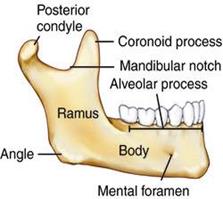The skull
The lower jaw has its own separate bone which is called 'the mandible', which is U-shaped and stretches from one ear, down to the chin area and then back up again to the other ear. It is joined to the upper part of the head around the ear region by two jaw joints (called 'temperomandibular joints'). If your rest your fingers on the skin just in front of your ears, and then open and close your mouth, you can feel the jaw joints moving. The mandible has names for its different parts, as follows:

| The body of the mandible is the middle section of the U-shape which supports the lower teeth. The condyle is the rounded end of bone that fits into the movable joint between the mandible and the cranium (the part of the skull which encloses the brain). There is one on each side of the mandible. The coronoid process is the name for a triangular projection from the mandible which joins one of the chewing muscles to the cranium. There is one on each side of the mandible. The ascending ramus is the flatter, straighter part on the sides of the lower jaw which joins the body of the mandible to the coronoid processes and the condyles. |
The maxilla is a name for the upper jaw, and it is made up of several bones stuck (or fused) together, and sits in front of and just below the cranium. It is attached to the cranium and forms the cheeks, the nose, and the roof of the mouth.
| The maxillary antrum or sinus is the name for the air filled space that sits just under the cheekbone, and just above the roof of the mouth. There is one on each side of the face, either side of the nose. The anterior nasal spine is a bit of bone which protrudes from the maxilla at the lower end of the nose. The zygomatic process is a curved piece of bone which extends outwards from the maxilla and forms part of the cheekbone. The palate is the roof of the mouth, it separates the nose and the mouth: the hard part is called the 'hard palate' and is towards the front of the mouth, and the softer part at the back near the throat is the soft palate. | 
|
The temperomandibular joint (TMJ) is the movable joint between the mandible (lower jaw bone) and part of the cranium called the temporal bone. It is a complicated joint and the two hard bone surfaces are separated by a circular piece of softer cartilage which acts like a cushion.
The lower jaw movs up and down, sideways and forwards. This joint is in constant use during chewing, swallowing, talking, and laughing. Some of these movements involve rotation of the joint and some are sliding movements.
A foramen is an opening or hole which lets nerves and blood vessels pass through bone. The plural of foramen is foramina. The mental foramen is on the body of the mandible. Nerves and blood vessels which travel to the lower lip pass through this. The mandibular or inferior dental foramen is on the ascending ramus. A nerve called the inferior dental nerve and blood vessels which go to the lower teeth pass through this. The incisive foramen is at the front of the palate (the roof of the mouth). Nerves called incisive nerves and the blood vessels which supply the front of the palate pass through this.
| condyle ['kOndIl] мищелок coronoid['kOrqnOId]клювовидний process ['prəuses] відросток ramus [reI'mAs] гілка, відгалудження | foramen[fə'reɪmen] отвір nasal spine ['neɪz(ə)l spaɪn] носовий гребінь mental['ment(ə)l] підборідний incisive[ɪn'saɪsɪv] різцевий; що стосується різців |